Aggressive investors should include emerging markets in their portfolios for up to 20% of equity exposure. I believe that EEM and SPY are in a multi-year period of moving together with EEM likely to outperform, asserts Marvin Appel, MD, PhD.
Get Trading Insights, MoneyShow’s free trading newsletter »
The iShares MSCI Emerging Markets Index ETF (EEM) is 2% off of its high, compared to just 0.5% for the S&P 500 SPDR (SPY).
But EEM still looks more attractive over the long term for a number of reasons. First, the ratio of EEM/SPY continues its trend of EEM outperformance since December.
As long as EEM/SPY is above the 200-day moving average of that ratio, EEM is favored.
Confirmation of the greater strength in EEM comes from its MACD, which confirmed the new price high that EEM reached in July. In contrast, numerous equity ETFs from the U.S. and developed countries formed negative divergences with their MACDs, showing weaker momentum than EEM.
For example: PowerShares QQQ Trust Series 1 ETF (QQQ), iShares MSCI EAFE Index Fund ETF (EFA), iShares Europe ETF (IEV) and SPY.
Despite the strength in emerging markets stocks this year, valuations remain reasonable. Data from Ned Davis Research shows that emerging markets stocks are cheaper than U.S. equities; The MSCI Emerging Markets Index has a trailing earnings yield of 6.5% compared to 4.5% for the S&P 500.
Since 2012, earnings yields in both of these indexes have moved roughly in parallel. If anything, emerging market stocks have become a bit more of a bargain relative to the S&P 500 Index over the past five years.
Recommendation
Aggressive investors should include emerging markets in their portfolios for up to 20% of equity exposure. Trading EEM in accordance with our U.S. equity timing models would not have been successful from 2011-2015, a period when the S&P 500 advanced while EEM fell. However, I believe that EEM and SPY are in a multi-year period of moving together with EEM likely to outperform. Sell out of emerging markets whenever our U.S. equity models turn neutral or worse.
Subscribe to investment newsletter Systems and Forecasts here…



















